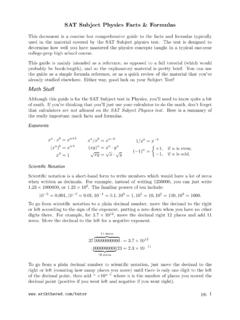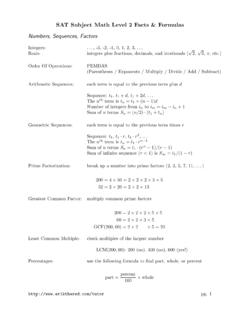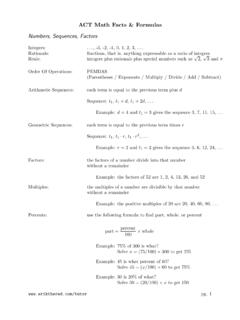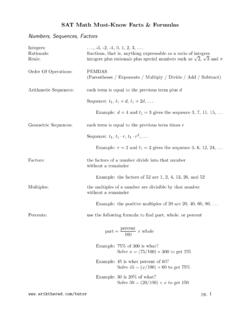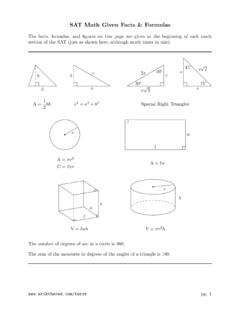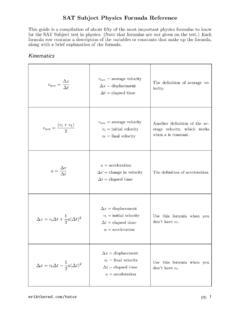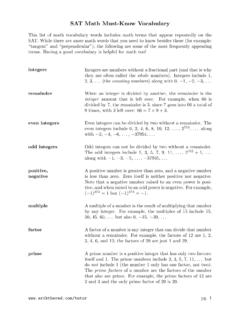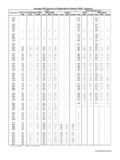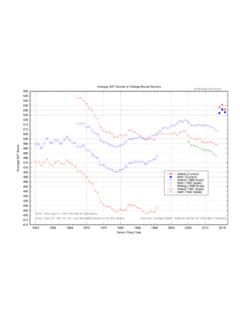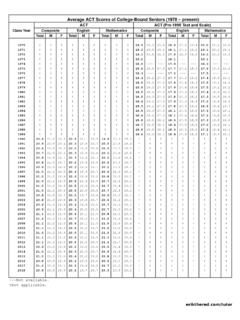Transcription of Kinematics - erikthered.com
1 SAT Subject Physics Formula Reference This guide is a compilation of about fifty of the most important physics formulas to know for the SAT Subject test in physics. (Note that formulas are not given on the test.) Each formula row contains a description of the variables or constants that make up the formula, along with a brief explanation of the formula. Kinematics vave = average velocity x The definition of average ve- vave = x = displacement t locity. t = elapsed time vave = average velocity Another definition of the av- (vi + vf ). vave = vi = initial velocity erage velocity, which works 2. vf = final velocity when a is constant. a = acceleration v a= v = change in velocity The definition of acceleration. t t = elapsed time x = displacement 1 vi = initial velocity Use this formula when you x = vi t + a( t)2 don't have vf . 2 t = elapsed time a = acceleration x = displacement vf = final velocity 1 Use this formula when you x = vf t a( t)2 t = elapsed time don't have vi.
2 2. a = acceleration pg. 1. SAT Subject Physics Formula Reference Kinematics (continued). vf = final velocity vi = initial velocity Use this formula when you vf2 = vi2 + 2a x a = acceleration don't have t. x = displacement Dynamics F = force Newton's Second Law. Here, F = ma m = mass F is the net force on the mass a = acceleration m. W = weight The weight of an object with W = mg m = mass mass m. This is really just g = acceleration due Newton's Second Law again. to gravity f = friction force The Physics is Fun equa- tion. Here, can be either = coefficient f = N the kinetic coefficient of fric- of friction tion k or the static coefficient N = normal force of friction s . p = momentum The definition of momentum. m = mass It is conserved (constant) if p = mv there are no external forces on v = velocity a system. pg. 2. SAT Subject Physics Formula Reference Dynamics (continued). p = change in momentum p = F t F t is called the impulse.
3 F = applied force t = elapsed time Work, Energy, and Power W = work F = force Work is done when a force W = F d cos . d = distance is applied to an object as it or moves a distance d. Fk is the = angle between F. W = Fk d component of F in the direc- and the direction tion that the object is moved. of motion Fk = parallel force KE = kinetic energy The definition of kinetic en- 1. KE = mv 2 m = mass ergy for a mass m with veloc- 2. v = velocity ity v. PE = potential energy m = mass The potential energy for a PE = mgh g = acceleration due mass m at a height h above to gravity some reference level. h = height pg. 3. SAT Subject Physics Formula Reference Work, Energy, Power (continued). The work-energy theorem: W = work done the work done by the net force W = (KE). KE = kinetic energy on an object equals the change in kinetic energy of the object. E = total energy The definition of total ( me- chanical ) energy.
4 If there E = KE + PE KE = kinetic energy is no friction, it is conserved PE = potential energy (stays constant). P = power Power is the amount of work W done per unit time ( , power P = W = work t is the rate at which work is t = elapsed time done). Circular Motion ac = centripetal acceleration The centripetal acceleration v2 for an object moving around ac = v = velocity r in a circle of radius r at veloc- r = radius ity v. Fc = centripetal force The centripetal force that is 2. mv m = mass needed to keep an object of Fc =. r v = velocity mass m moving around in a circle of radius r at velocity v. r = radius pg. 4. SAT Subject Physics Formula Reference Circular Motion (continued). v = velocity This formula gives the veloc- 2 r ity v of an object moving once v= r = radius T around a circle of radius r in T = period time T (the period). 1 f = frequency The frequency is the number f= of times per second that an T T = period object moves around a circle.
5 Torques and Angular Momentum = torque = rF sin r = distance (radius) Torque is a force applied at a distance r from the axis of ro- or F = force tation. F = F sin is the = rF = angle between F component of F perpendicu- and the lever arm lar to the lever arm. F = perpendicular force L = angular momentum Angular momentum is con- m = mass served ( , it stays constant). L = mvr v = velocity as long as there are no exter- nal torques. r = radius pg. 5. SAT Subject Physics Formula Reference Springs Fs = spring force Hooke's Law . The force is Fs = kx k = spring constant opposite to the stretch or com- x = spring stretch or pression direction. compression The potential energy stored PEs = potential energy in a spring when it is ei- 1 2 k = spring constant ther stretched or compressed. PEs = kx 2 x = amount of Here, x = 0 corresponds to spring stretch the natural length of the or compression spring.
6 Simple Harmonic Motion r Ts = period of motion The period of the simple har- m monic motion of a mass m at- Ts = 2 k = spring constant k tached to an ideal spring with m = attached mass spring constant k. s Tp = period of motion l The period of the simple har- Tp = 2 l = pendulum length monic motion of a mass m on g g = acceleration due an ideal pendulum of length l. to gravity pg. 6. SAT Subject Physics Formula Reference Gravity Fg = force of gravity Newton's Law of Gravitation: m1 m2 G = a constant Fg = G 2 this formula gives the attrac- r m1 , m2 = masses tive force between two masses r = distance of a distance r apart. separation Electric Fields and Forces F = electric force Coulomb's Law . This for- q1 q2 k = a constant F =k 2 mula gives the force of attrac- r q1 , q2 = charges tion or repulsion between two r = distance of charges a distance r apart. separation A charge q, when placed in an F = electric force electric field E, will feel a force E = electric field on it, given by this formula F = qE.
7 (q is sometimes called a test . q = charge charge, since it tests the elec- tric field strength). E = electric field This formula gives the elec- k = a constant tric field due to a charge q at q a distance r from the charge. E=k q = charge r2 Unlike the test charge, the r = distance of charge q here is actually gen- separation erating the electric field. pg. 7. SAT Subject Physics Formula Reference Electric Fields and Forces (continued). This formula gives the elec- UE = electric PE. tric potential energy for two k = a constant charges a distance r apart. q1 q2. UE = k q1 , q2 = charges For more than one pair of r r = distance of charges, use this formula for separation each pair, then add all the UE 's. The potential difference V. between two points is defined V = potential difference as the negative of the work done by the electric field per WE UE WE = work done by E field V = = unit charge as charge q moves q q UE = electric PE from one point to the other.
8 Q = charge Alternately, it is the change in electric potential energy per unit charge. V = electric potential This formula gives the electric potential due to a charge q at q k = a constant V =k a distance r from the charge. r q = charge For more than one charge, use r = distance of this formula for each charge, separation then add all the V 's. Between two large plates of metal separated by a distance E = electric field V d which are connected to a E= V = voltage battery of voltage V , a uni- d d = distance form electric field between the plates is set up, as given by this formula. Circuits Ohm's Law . This law gives V = voltage the relationship between the V = IR I = current battery voltage V , the current R = resistance I, and the resistance R in a circuit. pg. 8. SAT Subject Physics Formula Reference Circuits (continued). P = IV. P = power All of these power formulas or I = current are equivalent and give the P = V 2 /R power used in a circuit resistor V = voltage or R.
9 Use the formula that has R = resistance the quantities that you know. P = I 2R. Rs = total (series) When resistors are placed end resistance to end, which is called in se- Rs =. R1 = first resistor ries , the effective total resis- R1 + R2 + .. R2 = second resistor tance is just the sum of the in- .. dividual resistances. Rp = total (parallel) When resistors are placed side 1 by side (or in parallel ), the = resistance Rp effective total resistance is the R1 = first resistor 1 1 inverse of the sum of the re- + +.. R2 = second resistor ciprocals of the individual re- R1 R2 .. sistances (whew!). This formula is Ohm's Law . for capacitors. Here, C is a q = charge number specific to the capac- q = CV C = capacitance itor (like R for resistors), q is V = voltage the charge on one side of the capacitor, and V is the volt- age across the capacitor. pg. 9. SAT Subject Physics Formula Reference Magnetic Fields and Forces This formula gives the force F = force on a wire on a wire carrying current I.
10 I = current in the wire while immersed in a magnetic L = length of wire field B. Here, is the angle F = ILB sin B = external magnetic field between the direction of the current and the direction of = angle between the the magnetic field ( is usu- current direction and ally 90 , so that the force is the magnetic field F = ILB). The force on a charge q as it F = force on a charge travels with velocity v through q = charge a magnetic field B is given by v = velocity of the charge this formula. Here, is the F = qvB sin angle between the direction of B = external magnetic field the charge's velocity and the = angle between the direction of the magnetic field direction of motion and ( is usually 90 , so that the the magnetic field force is F = qvB). Waves and Optics This formula relates the wave- v = wave velocity length and the frequency of a v = f = wavelength wave to its speed. The for- f = frequency mula works for both sound and light waves.
